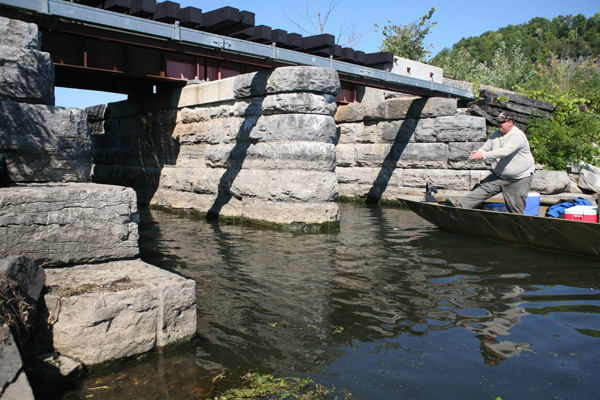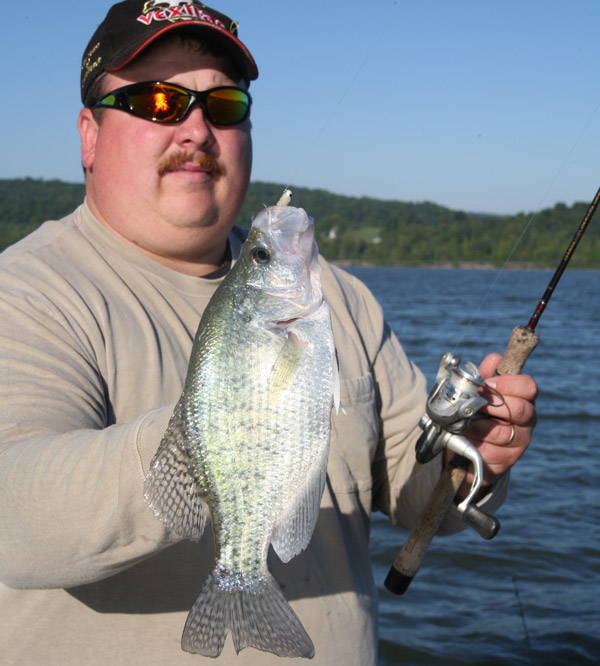 Fish & Tackle: Under Bridges for Crappie
Fish & Tackle: Under Bridges for Crappie
By Fish & Tackle Editor Vic Attardo

Normally an early riser, especially on fishing days, I had gotten a late start. Arriving at the boat ramp, I found the launch clogged with the trailer-challenged. The upshot was I didn’t get on the water until after 10 o’clock, and by then the June sun was riding high.
My original plan had been to fish for crappies along the craggy riprap on the east side of Kerr Reservoir, a 50,000-acre impoundment in southern Virginia and North Carolina. But the angle of the sun put the kibosh on that idea. I needed some shade to catch crappies in the warming water, and as I looked out to the Buggs Island bridges at Clarksville, I saw plenty of cool darkness.
Bridges often provide the widest shady areas on a lake, also typically the deepest. And unlike at most docks, there is current. The three—shade, depth and current—can make a bridge the lake hotspot for late spring and summer crappies.
Two bridges cross over to Buggs Island, close together and nearly identical. This morning, I marked the better shade on the lower of the two and motored over there. One of the tricky things about fishing bridge shade is that it moves with the track of the sun. A low sun typically limits the amount of fishable shade, but a high sun can throw a deep shadow from one end of a bridge to the other, which was the case this day at the lower bridge.
The Staunton and Dan tributary rivers provide the flow under the bridges, and I maneuvered my boat below the downstream side of a pillar. The sonar read a depth of 12 feet from the footing, more than ample for crappies.
I cast a Road Runner bladed jig where I could retrieve it with the current, close to the shaded cement base. I let the jig fall to bottom on a semi-slack line and then began a slow retrieve. When the bait came to the end of the column, I felt a solid tug and lifted the rod tip. The first fish of the day was a 14-inch beauty. With that encouragement, and considering my late start, I decided to fish through the day.
As the sun crossed the sky, the shadows changed position, and I maneuvered from the downstream to the upstream side of the pillar. I no longer had the advantage of working with the current, but I was able to keep the bait in the shade with the fish, and I caught some dandies. Local anglers like to anchor their boats on the submerged crossbeams between those pillars, others just wade out and stand on the submerged footing, where they can fish the deep, shaded current without benefit of a boat.
I make it a habit to fish lake bridges for summer crappies. When the bite sours in other areas, bridges may be the only places to find concentrations of feeding fish. However, one can’t just motor up to a bridge, drop anchor and catch fish. A combination of conditions, or lack thereof, often means the difference between a spot that holds crappies and one that doesn’t.
On Foster Sayers Lake in central Pennsylvania, a rather low highway bridge spans the narrowest neck of the lake. It’s about a football field’s length, though the water around the supports isn’t particularly deep. Yet when the shade deepens under the bridge, there is no better place to catch early-summer crappies.
The best crappie action at the Sayers bridge is around the riprap at either end and in the main channel around the center pillar. Most days, there’s not much current, so the crappies don’t orient specifically to the upstream or downstream side. It is one of the few bridges I know where reading current plays no part in finding fish.
I like to drift under the bridge, tossing a tiny jig and trailer under a small slip-float. I start in the sun, pulling the float and jig slowly behind the boat. As I drift under the bridge, the float and jig enter the shade, and the crappies bite, often as soon as the bait gets into shaded water.
Other days, the offering has to be in the darkest water. As is the case at many bridges, well-defined “sweet spots” typically hold most of the fish.
Near in-flows, the current under a bridge may be the same for days at a time. At such bridges, look for a bending current on the upstream side of a pillar. Where this current is strong, it may be seen on the surface as a distinct ripple. Often, there is a scooped-out pocket on the bottom ahead of the pillar, as if someone took a big ice-cream dipper to it. Crappies and other fish use this scoop as a place to hold and grab food as the current brings it by.
Surface debris may also collect on the upstream side of such a pillar, typically a mix of tree limbs and man-made junk. Crappies often hold in the shade under this cover, and where the flow is light, the hot ticket may be to simply let a slip float carry your bait right up to the edge.
A bladed jig typically works better for more precisely located presentations in faster water.
The downstream end of a bridge pillar also can be a great place to fish for crappies, especially where the current is steady. These current breaks provide places where crappies hold without expending much energy. On the downstream end, the bottom is typically deepest right around the support, gradually rising and leveling out several yards beyond the column.
Crappies like the deep current break directly behind the column.
When water is let in or out of a lake, the flow may change direction and reposition crappies on the other side of a bridge pillar. Wind can also alter the position of crappies under a bridge.
A narrow bar of solid land separates Lake Champlain’s backwaters from the main lake, with a railroad running along the top of the bar. Old stone bridges, some with only side supports or one center support, let the water flow between this backwater and the main lake.
Locals call these sites “suck-holes,” and when the wind is driving current, it’s easy to see why. As the wind pushes water from one side to the other, the crappies often change position. Here, shade is not so much a factor as is current.
One day last fall, a brisk wind was pushing water from the backwater out into the main lake. It was necessary to position the boat in the main lake, actually a big bay, and cast up under the low railroad bridge. I’d let a slip float with a minnow-tipped jig drift up against the stone side of the bridge, and strikes came as the bait passed over a pocket in the bottom where the crappies had settled.
The next time out, a lack of wind changed the position of the crappies under one of the best bridges. There was no wind-push this day, it hadn’t rained for some time, and the backwaters were receding, not pushing current under the bridge. As a result, it was better to maneuver the boat under the low bridge—not an easy task—and then fish the deep pocket on the backwater side of the support.
A lake bridge can be an excellent location to catch summer crappies. But you have to play the shade and find the deep current breaks to make the most of the situation. The only disadvantage is the honking horns of the motorists who drive overhead, no doubt wishing that they were fishing, too. I always hope they are paying as much attention to their driving.
